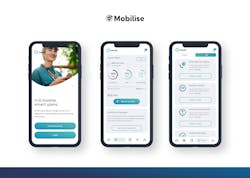Small and Large Telcos Must Elevate the User Experience
In its Top 7 trends shaping digital transformation in 2022 report, Mulesoft claimed the 2020s as the era of seamless digital experiences, enabled by modular software design. The takeaway is consumers are expecting the same quality of User Experience (UX) from their Communications Service Provider (CSP) as they receive from tech giants like Amazon and Meta. And they don’t care if you are a behemoth or a smaller telco. You still must offer a UX that’s on par with tech giants to remain competitive and keep your customers happy.
According to PricewaterhouseCoopers’ (PWC) Future of CX report, 32% of all customers would stop doing business with a brand they once loved after just one bad experience. So, a positive UX right from the start is crucial.
Shockingly, most organizations don't have a comprehensive data strategy in place. According to Capgemini’s Master the customer experience report, just 21% of brands have an integrated, holistic view of all customer information. For the others, data is scattered in silos in incompatible formats, and in some cases, it’s not even captured and stored.
Thankfully, APIs can help solve these issues. API-led connectivity links data to applications through application programming interfaces (APIs). It decouples data from the business logic and experience layer to create functions specifically with CX in mind. APIs are developed for specific purposes, but once created, they are reusable. So, adopting an API-led connectivity model allows an organization to create ecosystems of applications that are modular, purposeful, and reusable, enabling businesses to operate with more agility.
Implementing API integrations, or an orchestration layer, into an organization’s digital infrastructure supports digital CX in many ways. APIs enable the full integration of external systems and third-party services so that processes appear seamless. What is actually a sequence of several individual processes and triggers behind the scenes, enabled through applications from several vendors, can appear as a single interaction to a customer.
For example, in telecoms, when onboarding a new customer through an in-app eSIM subscription, subscriber provisioning, stock management and Know Your Customer (KYC) is all handled by APIs. Yet for the customer, all that’s required is the tap of a button.
“The takeaway is consumers are expecting the same quality of user experience (UX) from their Communications Service Provider as they receive from tech giants like Amazon and Meta.”
APIs also create a centralised architecture to unite data from various business systems and give one version of the truth for every corner of an organization. Data orchestration is the process of taking siloed data from multiple storage locations, collating and organizing it, and making it available for analysis. Data orchestration enables businesses to automate and streamline data-driven decision-making, a necessary capability for organizations to succeed in a digital-first world.
Yet the largest benefit of adopting an API-led modular architecture is its impact on operational agility. SPs can become more flexible in their technical architecture and create a truly digital ecosystem. By adding new service offerings, like additional payment gateways, simply and quickly through reusable APIs, SPs can offer their customers a greater level of choice, constantly improving CX. What’s more, the modularity means that SPs can freely switch the technologies they integrate into their digital propositions without impacting functionality or needing extended periods of downtime—this also avoids vendor lock-in.
For smaller SPs, having the resources and expertise to successfully implementing an API-led digital architecture may seem an impossible task. One option they can explore is Mobilise’s HERO. (See Figure 1.) Its digital BSS platform enables SPs to deliver digital-first customer experience. Through its orchestration layer, which is fully compliant with the TM Forum Open API Specifications, there are over 60 APIs available to integrate into front and back-end systems, for functions including self-service, eSIM provisioning, payments, in-app push notifications, marketplace for cross selling, and user profiles maintenance.
Preventing churn, maintaining satisfied customers and elevating CX is essential to success in the ever more competitive telecoms space. Creating a consistent, intuitive digital ecosystem, powered by APIs, gives SPs the ongoing flexibility to adapt and keep pace with innovation.
ABOUT THE AUTHOR
Hamish White is Founder and CEO, Mobilise. He has more than 20 years of experience in telecoms and technology. For more information, please email [email protected]. Learn more about the latest activities and news from Mobilise by visiting https://www.mobiliseglobal.com/insights/. Follow them on Twitter: https://twitter.com/MobiliseGlobal, LinkedIn: https://www.linkedin.com/company/mobiliseglobal/, Facebook: https://www.facebook.com/MobiliseGlobalTeam, and Instagram: https://www.instagram.com/mobiliseglobal/
About the Author
Hamish White
CEO, Mobilise
Hamish White is CEO of telecoms software provider Mobilise. He has more than 20 years of experience in supporting Tier 1 & Tier 2 International Telecommunications Operators. For more information, email [email protected] or visit www.mobileseglobal.com. Follow Mobilise on LinkedIn, Twitter, Facebook, and Instagram.


